Indoor plants bring beauty, freshness, and calm to any living space, but keeping them healthy can sometimes be challenging—especially when it comes to humidity. While many people focus on watering, light, and soil, one of the most overlooked factors in plant health is the moisture content in the air.
For tropical and humidity-loving plants like ferns, orchids, calatheas, and peace lilies, dry indoor air can lead to brown leaf edges, curling, and poor growth. Fortunately, there’s a simple and effective solution—humidifiers. When used correctly, humidifiers can recreate the natural moisture levels that plants thrive in.
In this article, we’ll explore everything you need to know about using humidifiers for indoor plants—why humidity matters, how to choose the right type, placement tips, maintenance advice, and how to create the ideal environment for your indoor jungle.
Why Humidity Is So Important for Indoor Plants
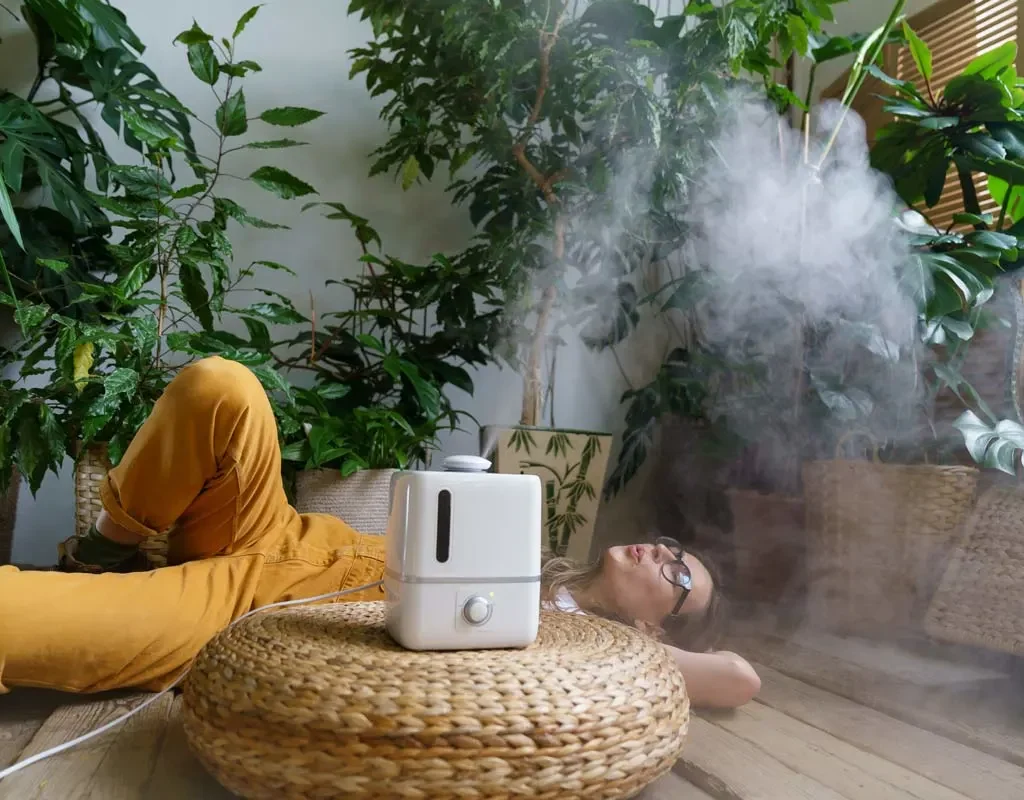
Humidity refers to the amount of water vapor present in the air. Most houseplants, especially those originating from tropical rainforests, thrive in environments where humidity levels are between 50% and 80%. Unfortunately, most indoor spaces, particularly during winter or when air conditioning is running, have humidity levels between 20% and 35%—far too dry for many species.
When humidity drops too low:
- Leaves may curl or develop brown, crispy edges.
- Buds may fail to open or drop prematurely.
- Plants lose moisture faster through transpiration—their way of “breathing.”
- Overall growth slows down, and leaves may become dull or weak.
By adding a humidifier, you help your plants absorb moisture through the air, reduce stress, and maintain lush, vibrant foliage.
Signs Your Plants Need More Humidity
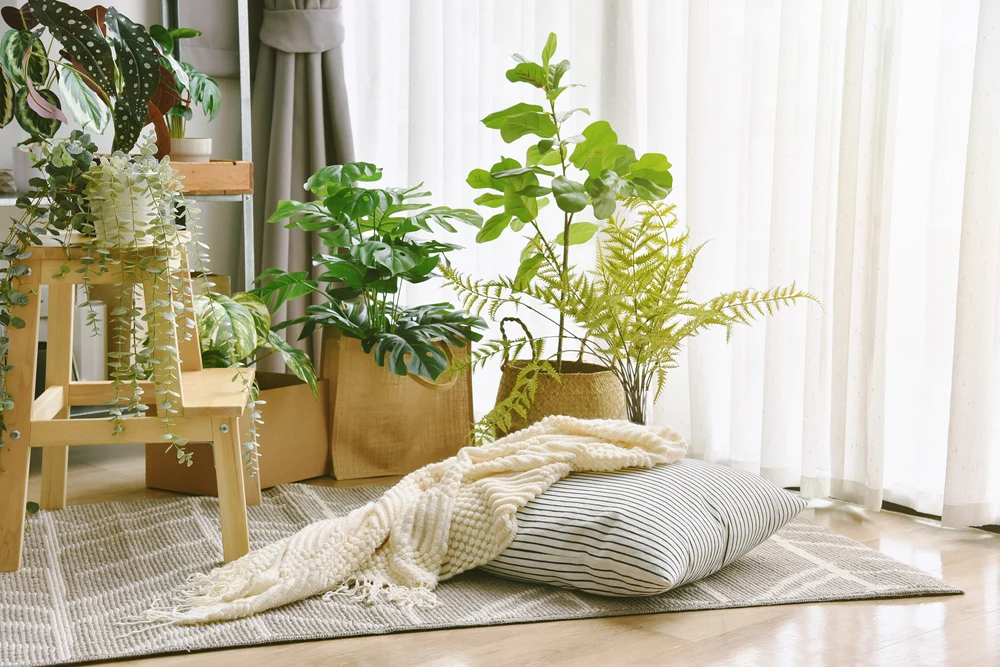
Before investing in a humidifier, look for these telltale signs that your plants are suffering from dry air:
- Brown or crispy leaf tips (common in ferns, calatheas, and spider plants).
- Leaf curling or drooping, even when soil moisture is adequate.
- Dry soil that quickly loses moisture after watering.
- Wilting or stunted growth in tropical species.
- Buds or flowers that drop early.
If you notice these symptoms, a humidifier can make a world of difference.
How Humidifiers Benefit Indoor Plants
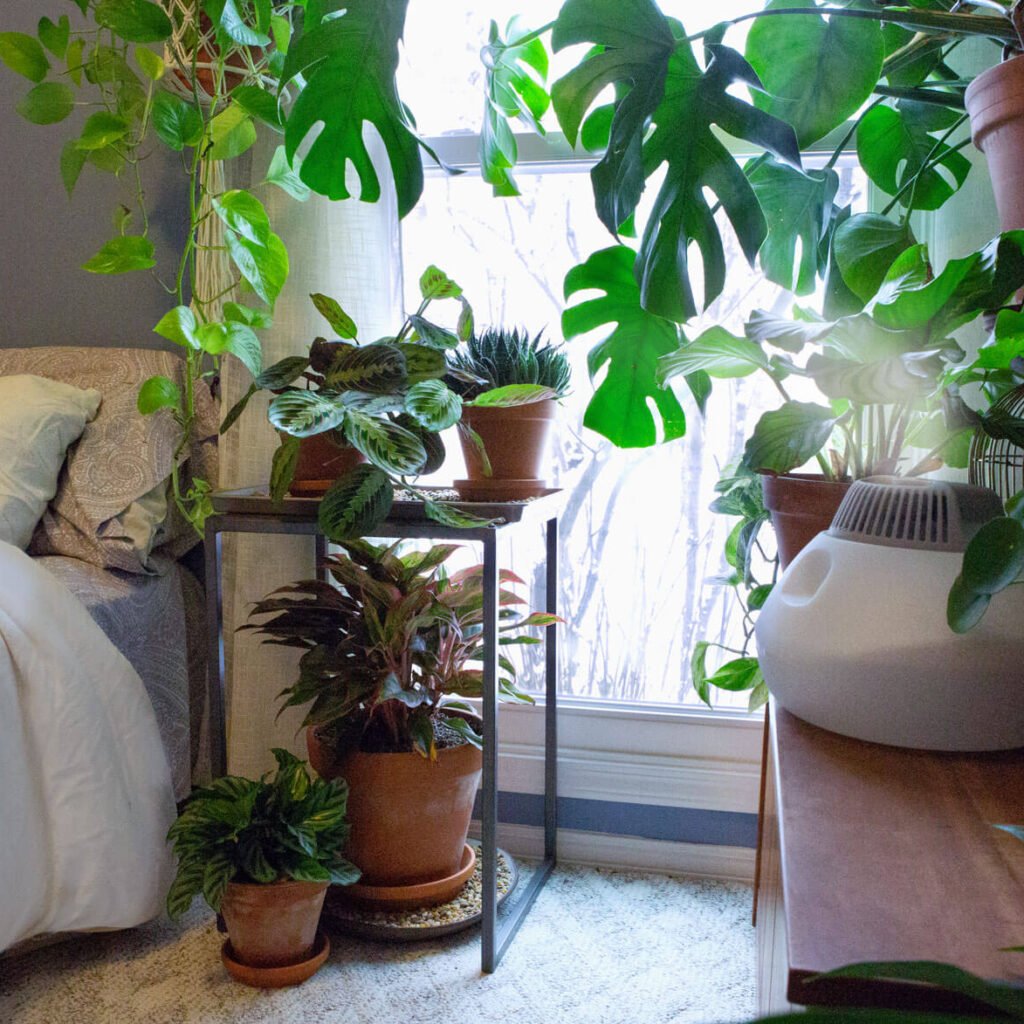
Humidifiers increase the amount of water vapor in the air, creating a microclimate that mimics a natural, tropical environment. The main benefits include:
- Improved moisture retention: Plants lose less water through their leaves.
- Better nutrient uptake: Roots work more efficiently in stable humidity.
- Healthier foliage: Prevents brown tips and leaf damage.
- Boosted growth: Encourages faster and stronger development.
- Reduced pest problems: Dry air attracts spider mites and thrips—humid air helps deter them.
By maintaining consistent humidity, your plants can focus on healthy growth rather than surviving stress.
Types of Humidifiers for Indoor Plants
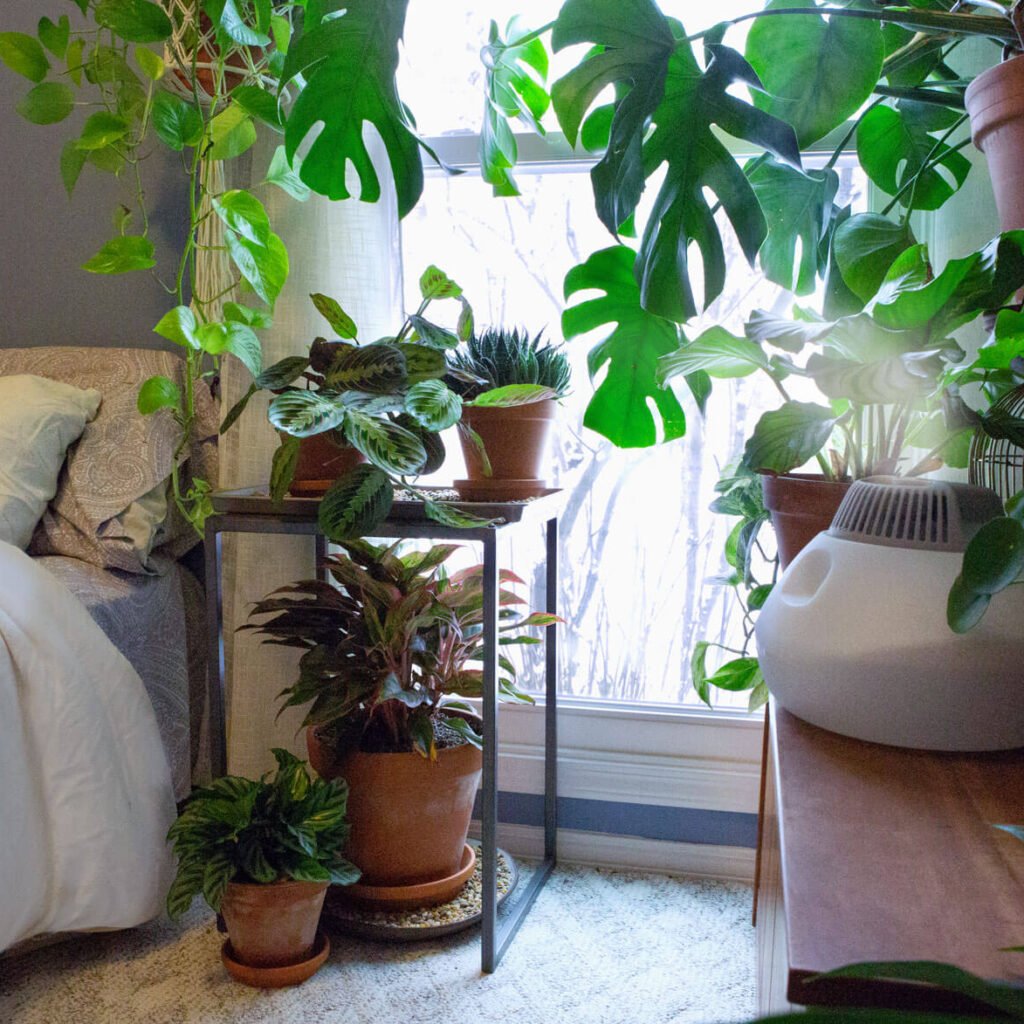
There are several types of humidifiers available, and each works a bit differently. Understanding them will help you choose the best one for your home garden.
1. Ultrasonic Humidifiers
These are the most popular and efficient options for plant enthusiasts. Ultrasonic humidifiers use high-frequency sound waves to break water into a fine mist, which is then dispersed into the air.
Pros:
- Quiet operation—great for bedrooms or living spaces.
- Energy-efficient and highly effective.
- Produces a cool, gentle mist that’s safe for plants.
Cons:
- Requires frequent cleaning to prevent mineral buildup.
- Best used with distilled or filtered water to avoid white dust.
Ideal For: Small to medium plant collections and tropical species.
2. Evaporative Humidifiers
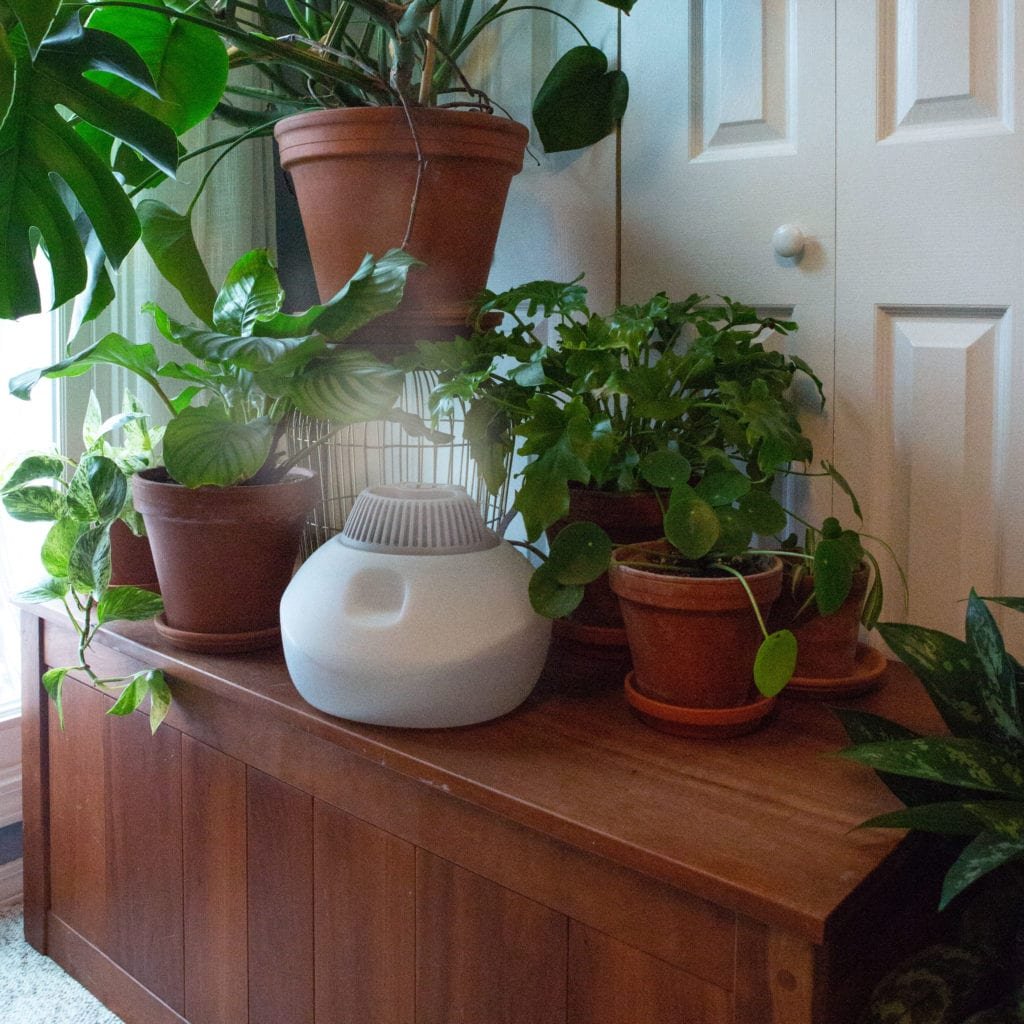
These use a fan to blow air through a wet wick or filter, naturally evaporating water into the air.
Pros:
- Self-regulating—humidity output slows as the air becomes moister.
- Affordable and widely available.
- Produces cool mist without leaving residue.
Cons:
- Can be noisier than ultrasonic models.
- Wicks and filters need replacement over time.
Ideal For: Larger plant setups or whole-room humidification.
3. Warm Mist (Steam) Humidifiers
These heat water to produce steam, which cools slightly before being released into the room.
Pros:
- Great for colder climates—adds warmth to the air.
- Helps reduce bacteria and mold in the water tank due to heat.
Cons:
- Can be hot to the touch—keep away from leaves or pets.
- Higher energy use.
Ideal For: Winter months or rooms that are already cool and dry.
4. Cool Mist Humidifiers
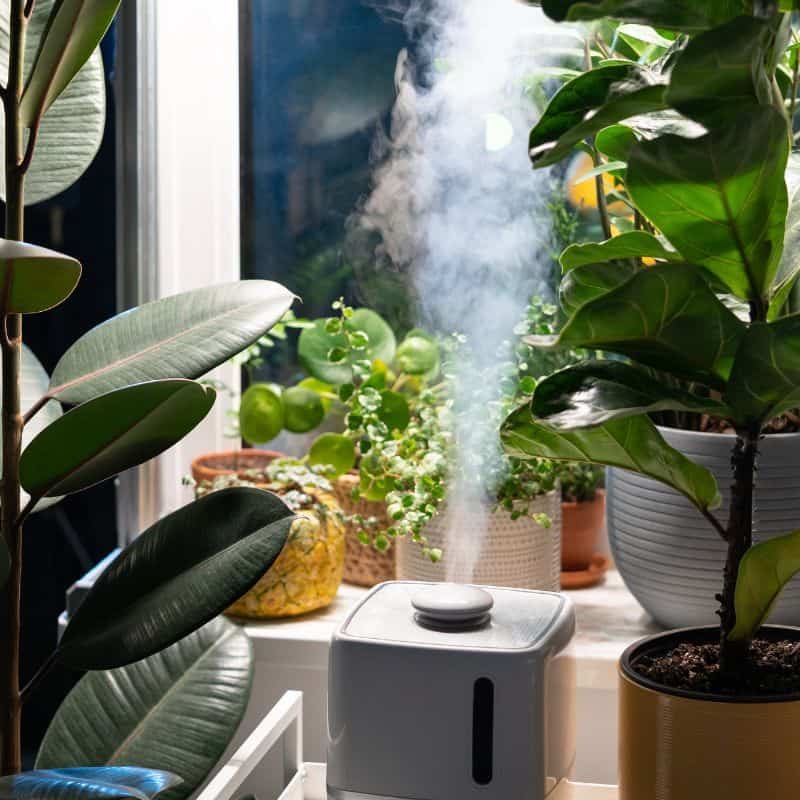
These release room-temperature mist and are safer for use around plants, pets, and children.
Pros:
- Energy-efficient and effective.
- Easy to maintain.
- Ideal for maintaining steady humidity in warm seasons.
Cons:
- May require frequent cleaning to prevent bacterial growth.
Ideal For: Year-round humidity maintenance.
How to Use a Humidifier for Indoor Plants
To get the best results, it’s important to use your humidifier correctly. Here are step-by-step tips to create an optimal environment for your green companions.
1. Choose the Right Location
- Place your humidifier close to your plants, ideally 2–4 feet away.
- Avoid placing it directly underneath leaves or flowers—excess moisture can cause fungal problems.
- Keep it on a stable, elevated surface to allow the mist to disperse evenly.
- In large rooms, consider multiple smaller humidifiers to ensure balanced coverage.
2. Set the Ideal Humidity Level
Most indoor plants thrive in 40–60% relative humidity.
- Use a hygrometer (humidity meter) to monitor levels.
- During dry winter months, you may need to run the humidifier longer.
- Avoid exceeding 70% humidity, as excessive moisture can encourage mold or mildew.
3. Run Your Humidifier Consistently
Plants prefer consistent humidity rather than sudden changes.
- Run your humidifier for several hours each day, especially in the morning or afternoon.
- Use a timer or smart plug to automate the process.
- If your home is very dry, consider leaving it on low throughout the day.
4. Use the Right Water
Tap water often contains minerals that can leave white residue or dust.
- Use distilled, filtered, or demineralized water for best results.
- This also prevents buildup inside the humidifier.
5. Maintain and Clean Your Humidifier Regularly
Dirty humidifiers can harbor bacteria and mold, which are harmful to both plants and humans.
- Empty and rinse the tank daily.
- Deep-clean weekly using vinegar or a mild disinfectant.
- Replace filters or wicks as needed.
Proper maintenance ensures clean, healthy humidity for your indoor garden.
Complementary Ways to Increase Humidity
In addition to humidifiers, you can use simple methods to keep the air around your plants moist:
- Group plants together: Plants release moisture through transpiration, creating a mini microclimate.
- Use pebble trays: Fill a shallow tray with pebbles and water—place pots on top so the evaporating moisture surrounds the plants.
- Mist plants occasionally: Lightly mist leaves in the morning, but avoid overdoing it to prevent fungus.
- Add water features: Small indoor fountains or aquariums can naturally raise humidity.
These techniques work well alongside a humidifier for optimal results.
Common Mistakes to Avoid
While humidifiers are helpful, using them incorrectly can cause issues. Avoid these pitfalls:
- Placing humidifiers too close to plants: Excessive moisture on leaves encourages mold or leaf rot.
- Over-humidifying the room: Constant high humidity can damage furniture and promote mold growth.
- Using unclean water: Minerals and impurities can clog the machine or settle on leaves.
- Neglecting maintenance: A dirty humidifier releases bacteria and spores into the air.
Regular monitoring and cleaning will ensure your plants get the right balance of moisture without unwanted side effects.
Best Humidifiers for Indoor Plants (2025 Recommendations)
If you’re ready to invest in a humidifier, here are a few top-rated options known for plant-friendly performance and reliability:
- Levoit Classic 300S Ultrasonic Humidifier – Quiet, smart app-controlled, and perfect for medium-sized plant areas.
- Honeywell Cool Mist Humidifier – Reliable, affordable, and great for consistent humidity control.
- Pure Enrichment MistAire Ultrasonic Humidifier – Compact and effective for small spaces.
- TaoTronics TT-AH001 Cool Mist Humidifier – Adjustable mist settings and automatic shutoff feature.
- Elechomes UC5501 Ultrasonic Humidifier – Large tank and dual mist nozzles for large plant collections.
Final Thoughts
Humidity plays a crucial role in keeping indoor plants healthy, lush, and happy. For many houseplants—especially tropical ones—it’s not just about watering or sunlight; the moisture in the air can make all the difference between dull, dry foliage and vibrant, thriving greenery.
A good humidifier helps recreate the natural conditions your plants crave, allowing them to absorb moisture, grow stronger, and resist stress. With proper placement, consistent use, and regular maintenance, you can turn your living space into a thriving indoor oasis year-round.
Remember: happy air means happy plants. So if your leaves are curling or crisping, it might be time to give your plants what they truly need—a little humidity love.
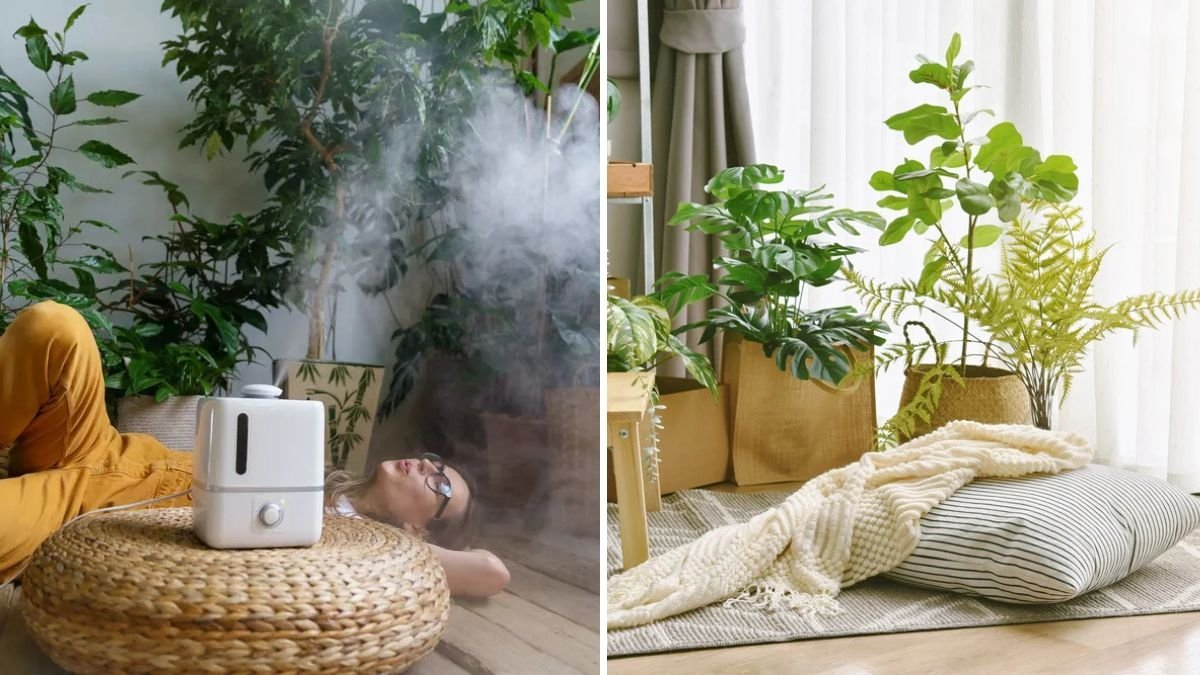




Leave A Comment